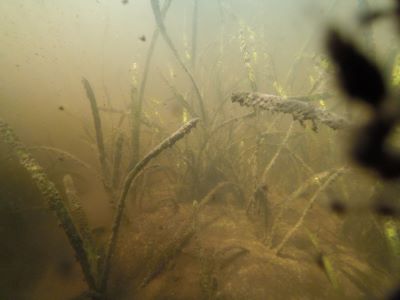by Mike Readling
Whether it’s manatees and other marine animals grazing their way through the flats or the abundance of fish that are returning to places they haven’t been for a couple years, the Caloosahatchee Seagrass Initiative showing some very promising signs.
 In October 2018, the Angler Action Foundation used Department of Environmental Protection funding to team up with Sea and Shoreline, LLC, and Johnson Engineering to plant new seagrasses in three areas of the Caloosahatchee River that had been destroyed by a series of catastrophic events. These areas, formerly thick with grass and sea life, had become sandy, muddy bottoms that harbored almost no marine life at all.
In October 2018, the Angler Action Foundation used Department of Environmental Protection funding to team up with Sea and Shoreline, LLC, and Johnson Engineering to plant new seagrasses in three areas of the Caloosahatchee River that had been destroyed by a series of catastrophic events. These areas, formerly thick with grass and sea life, had become sandy, muddy bottoms that harbored almost no marine life at all.
“This is a clear case where the removal of marine habitat led to what amounted to a marine wasteland,” said Angler Action Foundation Executive Director Brett Fitzgerald. “Part of the AAF mission is to replace lost habitats and this project is showing exactly how that can be done in the Caloosahatchee River. We couldn’t be prouder of the progress we’ve seen so far.
The Angler Action Foundation Caloosahatchee Seagrass Initiative is a $1 million project, funded by the Department of Environmental Protection, centered around three sites, two east I-75 and one west. Those sites feature a seagrass that is tolerant to freshwater and a freshwater grass that is amenable to brackish water.
A recent quarterly status check of the project showed the two eastern sites have undergone some heavy grazing by marine animals, mostly manatees and turtles. The western site shows less grazing pressure and, therefore, somewhat taller grasses.
"They’re getting grazed pretty heavily. It looks patchy or sparse, but there is a ton of plants there. They’re just short,” said Carter Henne, President of Sea and Shoreline. “In the downstream site where the grass is taller, there’s less grazing. Those plants are about 6 inches tall and there’s a lot of them.”
Henne said his team was focused on cleaning False mussels off the cages that protect many of the plants and allow the grass to grow unmolested until it can seed and spread out. The next goal is to see how big the original footprint has spread, thanks to those seeds.
“The plants are pumping out more plants. There are thousands of plants inside the cages that are throwing off rhizomes,” Henne said. “We have not looked outside the footprint but it’s likely they have started to colonize downstream sites, which is what we’re looking for.”
Fitzgerald agreed. "We're not out of the woods yet - a lot of critters depended on the historical seagrasses in the area. To get past a 'tipping point' where it can become self-sustaining will require continued maintenance of this site, plus some additional, strategic plantings."
Henne also mentioned the presence of fish in all the areas.
Snook, mojarra, mullet, baitfish, tilapia have all been spotted around the newly revived grass flats.
“FWC was out there doing an electrofish study and they said there was statistically more fish within the restoration areas than outside the restoration areas,” Henne said. “There was a Master’s student from Florida Gulf Coast University who just defended his thesis a couple months ago who studied the difference in the amount of marine life within the restored area, compared to outside the area.”
